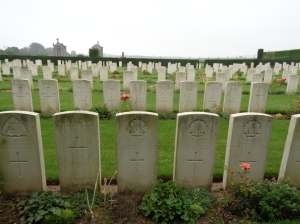VILLERS-BRETONNEUX MEMORIAL
On 7th August 2014 Stephen and I visited the Australian National Memorial at Villers-Bretonneux Military Cemetery, which is located about 2 km north of the village of Villers-Bretonneux. It was our second visit to this memorial.
The photograph below shows the Villers-Bretonneus Memorial, with some of the headstones in the Villers-Bretonneux Military Cemetery in the foreground.

Villers-Bretonneux Memorial, France (Photograph: S. & H. Thompson, 5/9/2012)
Red poppies grow in the garden beds near the entrance to the memorial. Beautiful roses and other flowers are planted in amongst the graves in the cemetery section. Bullet holes from World War II German aircraft can be seen on a wall, and on the tower.

Bullet holes in a wall at Villers-Bretonneux Memorial (Photograph: S. & H. Thompson, 7/9/2014)
A quite prophetic article in The Dubbo Liberal and Macquarie Advocate described the importance of this memorial, which was unveiled by King George VI on 22 July 1938, as follows:
‘A magnificent and dignified structure, it will perpetuate the memory of thousands of Australians who gave their lives on the battlefields of France in the greatest war the world has yet known. It is not the only war memorial dedicated to the memory of Australians and other sons of the Empire who died in France, but to us it is the most significant, for it marks the scene where Australians played an outstanding part in stemming the flow of the grey enemy hordes which threatened to engulf France. It was there, on April 24, 1918, that sons of Australia helped to halt the Germans who had burst through the British lines. It was the turning point of the war, for it was followed with a counter attack on April 24 – eve of the third anniversary of Anzac Day – which started the general allied advance that eventually brought peace. On that Anzac eve, there were 2500 Australian casualties, so the blood toll was heavy. The Villers-Bretonneux Memorial however, symbolises something more that the feats of arms and self-sacrifice of Australia’s sons. It stands as a reminder of the bond between France and the British Empire, cemented imperishably during 1914-18. Australians joined with the French in facing a common enemy, and France will not forget. Even when Time dims the memories of the awful horrors of the war years, the Villers-Bretonneux and other memorials will stand as mute sentinels of the friendship between the French and English. Generations to come will remember that French soil has been enriched by British blood; that sons of Australia and other parts of the Empire are sleeping beneath the poppies which blow on the foreign land they died to save …’[1]
The photograph below, taken from the tower at the top of the memorial, looking towards the main entrance, shows the size of the beautifully laid out site, and the rolling hills of the surrounding French countryside.

Looking from the Tower to the Main Entrance at Villers-Bretonneux Memorial (Photograph: S. &. H. Thompson 5/9/2012)
This Australian National Memorial was erected to commemorate all Australian soldiers who fought and died in France and Belgium during the First World War, and to name those who have no known grave.
According to the Commonwealth War Graves Commission website http://www.cwgc.org/, the names of 10,762 Australian soldiers are commemorated by this memorial. They died in the battlefields of the Somme, and Arras, and in the advance by the Germans in 1918, and the Allied advance to victory.
The memorial is situated behind the Villers-Bretonneux Military Cemetery, which contains the remains of graves brought in from other burial grounds and the battlefields in the area.
The names of 12 Coo-ees are commemorated at this memorial. Their names are listed in unit order on the walls.
Wilfred Ernest McDONALD 4th HTM Bty, who joined the Coo-ees at Wongarbon
Karl Alex Frederick NEILSEN 4th Pioneer BN, who joined the Coo-ees at Springwood
Oliver James HARMON 4th Pioneer BN, who joined the Coo-ees at Parramatta
John TARLINGTON 4th Pioneer BN, who joined the Coo-ees at Blayney
Francis Charles FINLAYSON 13th BN, who joined the Coo-ees at Parramatta
Stanley Everard STEPHENS 13th BN, who joined the Coo-ees at Gilgandra
Allan James DENMEAD 19th BN, who joined the Coo-ees at Bathurst
William Emerton HUNTER 45th BN, who joined the Coo-ees at Geurie
Lawrence Leslie MAGUIRE 45th BN, who joined the Coo-ees at Gilgandra
Jack MORRIS 45th BN, who joined the Coo-ees at Parramatta
William WEBBER 45th BN, who joined the Coo-ees at Ashfield
Rowland John WILSON 45th BN, who joined the Coo-ees at Lawson
A photograph of their name on the Villers-Bretonneux Memorial will be placed on each individual Coo-ee’s blog entry, and form part of a Roll of Honour for the fallen Coo-ees on this blog.
[1] Villers-Bretonneux, The Dubbo Liberal and Macquarie Advocate, 23 July 1938, p. 2, http://nla.gov.au/nla.news-article132276037












